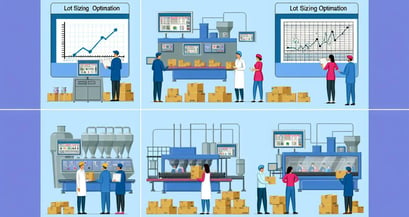Printing and Packaging: Trends to Watch in 2025
Explore the latest trends in the printing and packaging industry for 2025, from sustainable materials to smart packaging innovations.
Discover lot sizing techniques for efficient packaging manufacturing. Integrating APS and ERP systems for optimal results.
In the highly competitive manufacturing environment, packaging companies are constantly striving to improve their operational efficiency while minimizing costs. A crucial aspect of achieving this balance lies in optimizing lot sizes. Lot sizing plays a significant role in determining how much product to produce or purchase at a given time, affecting inventory levels, production schedules, and ultimately, the bottom line. As a Supply Chain Manager in a packaging manufacturing facility, you understand the challenges of optimizing lot sizes.
In this blog, we will look into the world of lot sizing optimization techniques, focusing on how integration between advanced planning and scheduling (APS) software like PlanetTogether and leading ERP, SCM, and MES systems (such as SAP, Oracle, Microsoft, Kinaxis, Aveva, and others) can significantly enhance your packaging manufacturing operations.

Lot sizing is the process of determining the quantity of items to be produced or purchased in each production or procurement run. It's a critical decision because it directly impacts various aspects of your supply chain, including:
Inventory Levels: Larger lot sizes can lead to higher inventory levels, tying up valuable working capital. Conversely, smaller lots can result in frequent changeovers and increased production costs.
Production Efficiency: Smaller lot sizes can lead to increased setup times, reducing overall production efficiency. Conversely, larger lots may result in excess inventory and the risk of obsolescence.
Lead Times: Lot sizes can influence lead times for both procurement and production, affecting your ability to meet customer demand.
Transportation Costs: Smaller lots can result in higher transportation costs due to more frequent shipments. Larger lots can lead to economies of scale but may require more significant storage space.
Customer Service: Optimized lot sizing can improve your ability to meet customer demand promptly and reduce the risk of stockouts or overstock situations.
Now, let's explore some of the lot sizing optimization techniques that can help you strike the right balance between these critical factors.

The Economic Order Quantity (EOQ) model is a classic approach to lot sizing optimization. It calculates the ideal order quantity that minimizes the total cost of ordering and holding inventory. The EOQ formula considers factors such as ordering costs, holding costs, and demand variability.
Integration Benefit: APS software like PlanetTogether can work in tandem with your ERP system to dynamically calculate and update EOQ values based on real-time data, ensuring that lot sizes are continually optimized.
The Periodic Order Quantity (POQ) model is suitable for situations with variable demand patterns. It determines the order quantity and order frequency that minimizes total costs over a fixed planning horizon. Unlike EOQ, which replenishes inventory when it reaches a specific level, POQ uses fixed-time intervals.
Integration Benefit: By integrating with APS software, your packaging facility can automatically adjust POQ parameters based on demand forecasts and real-time data, adapting to changing market conditions.
MRP is a comprehensive approach to lot sizing that considers not only inventory costs but also production constraints, lead times, and dependent demand. MRP software helps you plan and schedule production runs while optimizing lot sizes to meet customer demand efficiently.
Integration Benefit: MRP systems can be tightly integrated with both APS and ERP systems to ensure seamless communication between production planning, lot sizing, and procurement.
APS systems like PlanetTogether take lot sizing optimization to the next level by considering various constraints, including machine capacity, labor availability, and setup times. These systems use advanced algorithms to create optimal production schedules with optimized lot sizes.
Integration Benefit: Integrating APS with your ERP, SCM, and MES systems enables real-time data exchange, allowing you to make informed decisions based on up-to-date information.
Dynamic lot sizing techniques adapt lot sizes based on changing demand patterns, production constraints, and other factors. These approaches are particularly valuable in industries with highly variable demand or rapidly changing market conditions.
Integration Benefit: By integrating dynamic lot sizing techniques with your ERP and APS systems, you can ensure that lot sizes are continually adjusted to align with evolving supply chain dynamics.
The JIT philosophy aims to eliminate waste by producing and delivering products exactly when needed. JIT manufacturing often involves smaller lot sizes, reduced inventory levels, and frequent replenishments. Implementing JIT requires strong integration between production scheduling, inventory management, and supplier relationships.
Integration Benefit: Integrating your APS and ERP systems with JIT principles can help your packaging manufacturing facility achieve high levels of efficiency and responsiveness to customer demand.
![]()

Now, let's explore how integration between PlanetTogether APS software and leading ERP, SCM, and MES systems can supercharge your lot sizing optimization efforts:
Real-Time Data Sharing: Integration enables seamless data flow between systems, ensuring that PlanetTogether always has access to the most current information on demand, inventory levels, and production capacity.
Enhanced Forecasting: ERP systems can provide historical sales data and market trends, which PlanetTogether can leverage to improve demand forecasting and optimize lot sizes accordingly.
Collaboration: Integrated systems foster collaboration between different departments, such as production, procurement, and sales, leading to more informed decision-making.
Scenario Analysis: With data from your ERP system, PlanetTogether can run "what-if" scenarios to assess the impact of different lot sizing strategies on costs and customer service levels.
Automatic Replenishment: When integrated with MES and SCM systems, PlanetTogether can automatically trigger replenishment orders based on predefined triggers, reducing manual intervention and streamlining operations.
Optimizing lot sizes in your packaging manufacturing facility is a complex and crucial task. By implementing advanced lot sizing optimization techniques and integrating PlanetTogether with your ERP, SCM, and MES systems, you can achieve a higher level of operational efficiency, reduce costs, improve customer service, and gain a competitive edge in the market.
Remember that lot sizing optimization is an ongoing process, and it requires continuous monitoring, data analysis, and adjustment. By harnessing the power of integration and leveraging cutting-edge technology, you can stay agile in a rapidly changing business landscape and drive sustainable growth for your packaging manufacturing facility.
Are you ready to take your manufacturing operations to the next level? Contact us today to learn more about how PlanetTogether can help you achieve your goals and drive success in your industry.
Explore the latest trends in the printing and packaging industry for 2025, from sustainable materials to smart packaging innovations.
Be the first to know about new B2B SaaS Marketing insights to build or refine your marketing function with the tools and knowledge of today’s industry.